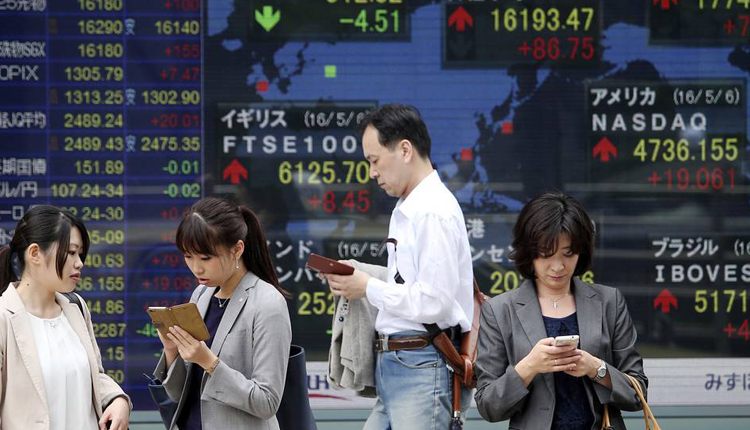Asian stocks traded higher on Monday afternoon after U.S. President Donald Trump’s announcement last week that tariffs would not be slapped on Mexican goods.
Mainland Chinese stocks were higher by the afternoon, with the Shenzhen component jumping 1.61% and the Shenzhen composite rising 1.473%. The Shanghai composite also gained 0.98%.
Over in Hong Kong, the Hang Seng index surged 2.03% as shares of Chinese tech giant Tencent soared 2.91%.
Official Chinese trade data for May showed the country’s exports beating forecasts and imports falling short of expectations, leaving it with an overall trade surplus of $41.65 billion for the month.
May exports in China rose 1.1% as compared to a year earlier against expectations of a 3.8% decline by analysts in a Reuters poll. Imports, which were also expected to fall 3.8%, dropped 8.5% instead.
The onshore Chinese yuan touched its lowest point in 2019 following the data release. It last traded at 6.9334 against the dollar, while its offshore counterpart also declined to 6.9523 against the greenback.
The Australian dollar, whose fortunes are often seen to be closely tied to that of China given the two countries’ trade relationship, changed hands at $0.6970 following an earlier high of $0.7022.
Japan’s Nikkei 225 jumped 1.03% in afternoon trade, while the Topix index gained 1.19%. Data on Monday showed that Japan’s economy grew at a slightly higher annualized rate than initially estimated —2.2% in the January to March period, as compared to economists’ median forecast of 2.1% growth in a Reuters poll.
South Korea’s Kospi also rose 0.92%, with shares of chipmaker SK Hynix gaining more than 1.5%.
Autos in both markets jumped on the news that Trump had withdrawn his tariff threat on Mexican goods. They had initially tumbled when the levies were announced.
South Korea’s Kia Motors surged as much as 4%, while Japan’s Toyota bounced 1.56%, and Nissan rose 0.96%. Mexico is used as a production base by many Japanese automakers.
Meanwhile, markets in Australia are closed on Monday for a holiday.
Trump announced last Friday that the U.S. and Mexico reached a deal to avoid the implementation of tariffs, originally set to kick in on Monday. In return, he said, Mexico agreed to take “strong measures” to strengthen immigration enforcement.
The latest development comes as the U.S. remains locked in a trade war with China as the two economic powerhouses hit an impasse in negotiations.
U.S. Treasury Secretary Steven Mnuchin, who has been among the lead negotiators involved in trade talks with China, told CNBC on Sunday that Trump will decide on whether to implement more tariffs on China after the American leader meets with Chinese President Xi Jinping later in June.
“We’re going to need to see action, and President Trump is going to need to make sure he’s clear that we’re moving in the right direction to a deal,” Mnuchin told CNBC. “The president will make a decision after the meeting.”
Trump has previously indicated he expects to plan his next trade moves after the G-20 meeting in Japan.
One investor told CNBC that the markets are “going to wait till that big event.”
“Everybody’s hopeful they will strike a deal, it’s not going to be (an) easy meeting. Quite clearly, there’s been a lot of … rhetoric going on between the Chinese and the U.S., you don’t see signs of compromise,” Vasu Menon, vice president of group wealth management at Singapore’s OCBC Bank, told CNBC’s “Squawk Box” on Monday.
Meanwhile, a drastic slowdown for jobs creation in May increased the odds that the U.S. would go on an easier monetary policy. Nonfarm payrolls were up by 75,000 in May — the second time in four months that the figure increased by less than 100,000. Economists surveyed by Dow Jones had been looking for a gain of 180,000.
Concerns over the potential impact of U.S. trade policy and signs of a slowing American economy have raised expectations that the Federal Reserve would slash interest rates.
The U.S. dollar index, which tracks the greenback against a basket of its peers, was at 96.776 after declining from levels above 97.6 last week. The Japanese yen traded at 108.60 against the dollar after touching levels below 108.0 last week.
Oil prices were higher in the afternoon of Asian trading hours, with the international benchmark Brent crude futures contract adding 0.52% to $63.62 per barrel and U.S. crude futures rising 0.61% to $54.32 per barrel.
Source: CNBC
